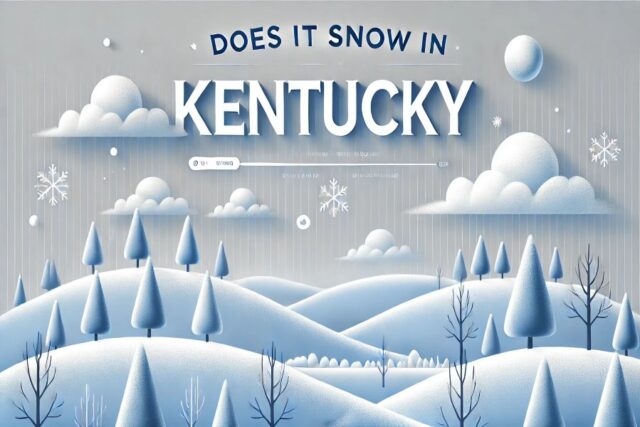Yes, it does snow in Kentucky during the winter months. Snowfall typically occurs between late November and early March, although measurable snow has been recorded in October and April as well.
Kentucky experiences varying levels of snowfall throughout the state, with some areas seeing more snow than others. Despite this, the overall snowfall in Kentucky is not as heavy as in some other northern states. Winter temperatures can get cold, but the severity of the winters in Kentucky can vary from year to year.
In this blog, we will explore the snowfall patterns in Kentucky, the impact of winter weather on the state, and what residents and visitors can expect during the winter months.
Kentucky’s Snowfall Patterns
Kentucky experiences snowfall between late November and early March, with measurable snow recorded in October and April. While the snowfall in Kentucky has been below average in some seasons, the state does receive snow during the winter months.
Average Snowfall Statistics
Kentucky, located in the southeastern part of the United States, experiences moderate snowfall during the winter months. According to the National Weather Service, the average annual snowfall in Kentucky ranges from 10 to 15 inches. The western part of the state tends to receive more snowfall than the eastern region. The highest snowfall recorded in Kentucky was in 1978, with 30 inches of snowfall in some parts of the state.
Regional Snowfall Variations
Kentucky’s snowfall patterns vary across the state’s regions. The Appalachian Mountains in eastern Kentucky receive more snowfall than the rest of the state due to their higher elevation. On average, these areas receive up to 20 inches of snowfall each winter. The Bluegrass region in central Kentucky receives less snowfall compared to other regions, with an average of 8 inches per year. The western region of Kentucky, which is closer to the Mississippi River, tends to receive more snowfall than the rest of the state, with an average of 15 inches per year.
In conclusion, Kentucky experiences moderate snowfall during the winter months, with an average annual snowfall of 10 to 15 inches. The Appalachian Mountains in eastern Kentucky receive the highest snowfall, while the Bluegrass region in central Kentucky receives the least. The western region of Kentucky tends to receive more snowfall than the rest of the state due to its proximity to the Mississippi River. Overall, Kentucky’s snowfall patterns vary across the state’s regions, making it a diverse and interesting place to experience winter weather.
Peak Snowfall Months In Kentucky
When it comes to snowfall in Kentucky, the peak months for experiencing winter wonderland are between December and February. Let’s take a closer look at the early snow predictions and late winter snow occurrences in the Bluegrass State.
Early Snow Predictions
As winter approaches, early snow predictions in Kentucky typically start to materialize towards the end of November and the beginning of December. While most parts of the state can expect measurable snowfall during this time, areas like Bowling Green often see their first snowflakes closer to Christmas.
Late Winter Snow Occurrences
Even as winter progresses into its later months, Kentucky may still experience late winter snow occurrences. Snow usually falls between late November and early March, but there have been recorded instances of measurable snow in October and April. The numbers don’t lie, as snowfall in Kentucky has been below average in recent seasons.
Kentucky’s Winter Climate
Kentucky experiences snowfall from late November to early March, with measurable snow occasionally in October and April. Louisville usually sees snow in winter, but snowfall in Kentucky has been below average this season. Snow is not as frequent in Kentucky compared to other states.
Temperature Trends During Winter
During the winter months in Kentucky, the temperature trends can vary significantly. The state experiences a mix of mild and cold weather, with temperatures ranging from around 30°F (-1°C) to 50°F (10°C) on average. However, it is important to note that these temperatures can fluctuate greatly depending on the region and specific weather patterns.
In the western part of Kentucky, temperatures tend to be slightly warmer compared to the eastern part. This is due to the influence of the Mississippi River and the warmer air currents from the south. Conversely, the eastern part of the state, including the Appalachian Mountains, experiences colder temperatures, especially at higher elevations.
It is also worth mentioning that Kentucky can occasionally experience extreme cold snaps during the winter months. These cold spells can bring temperatures below freezing for extended periods, causing significant drops in temperature and potentially contributing to increased snowfall.
Impact Of Climate On Snowfall
The climate in Kentucky plays a crucial role in determining the amount of snowfall the state receives during winter. The presence or absence of certain weather systems can greatly impact snowfall patterns.
Kentucky’s location within the transition zone between the colder north and the warmer south means that it can experience a wide range of weather conditions. This transitional climate often leads to varying snowfall amounts from year to year.
When colder air masses from the north collide with warmer, moist air masses from the south, it creates the ideal conditions for snowfall. These clashes can result in significant snowstorms and heavy snow accumulation in certain parts of the state.
However, it is important to note that Kentucky does not consistently receive heavy snowfall every winter. Some winters may see above-average snowfall, while others may have below-average amounts. Factors such as the strength and track of winter storms, as well as the temperature differentials, play a significant role in determining the snowfall amounts.
In conclusion, Kentucky’s winter climate is characterized by varying temperatures and the potential for snowfall. While the state does experience snow during the winter months, the amount and frequency can vary from year to year. It is essential to monitor weather forecasts and stay prepared for potential winter weather events.
Snow Activities And Events
When winter arrives in Kentucky, the snow-covered landscapes open up a world of exciting activities and events for locals and visitors to enjoy. From popular winter sports to festive snow-based events, Kentucky offers a variety of options to make the most of the snowy season.
Popular Winter Sports
- Skiing
- Snowboarding
- Snowmobiling
- Ice skating
Festivals And Snow-based Events
- Winter Wonderland Festival
- Snowman Building Competition
- Ice Sculpture Exhibitions
- Snowshoeing Tours
Snowfall Records And Extremes
Historical Snowfall Data
Looking back at historical snowfall data in Kentucky provides valuable insights into the state’s winter weather patterns. Kentucky typically experiences snowfall between late November and early March, with measurable snow sometimes recorded in October and April. The average annual snowfall totals in Kentucky vary across cities, towns, and parks, impacting the frequency and total amount of snowfall each year.
Recent Winters Compared To Averages
Assessing recent winters in Kentucky compared to historical averages reveals interesting trends. While the state has experienced periods of heavy snowfall in the past, recent winters have shown a noticeable deviation from these averages. Snowfall in Kentucky has been lacking in some winters, remaining below the expected levels. This deviation from historical averages highlights the dynamic nature of Kentucky’s winter weather and the variability in snowfall patterns over time.
Frequently Asked Questions
Does Kentucky Get A Lot Of Snow?
Yes, Kentucky does get snow, usually between late November and early March, with some measurable snowfall in October and April.
What Month Does It Snow In Kentucky?
Snowfall in Kentucky typically occurs between late November and early March, with measurable snow starting at the end of November. Bowling Green usually sees its first snow around Christmas.
Does Louisville, Kentucky Get Snow?
Yes, Louisville, Kentucky does get snow typically between late November and early March, with occasional snowfall in October and April.
Does Kentucky Get All 4 Seasons?
Yes, Kentucky experiences all four seasons, including winter with snowfall between late November and early March.
Faq 1: Does Kentucky Get A Lot Of Snow?
Kentucky does receive snowfall, but the amount varies. Snow usually falls between late November and early March, with measurable snowfall recorded in October and April as well.
Faq 2: When Does It Typically Snow In Kentucky?
Typically, measurable snowfall starts at the end of November or the beginning of December. Bowling Green is usually the last to see measurable snow, often around Christmas time.
Conclusion
Kentucky does receive snowfall during the winter season, typically between late November and early March. While some areas may see more snow than others, the state’s annual average snowfall is around 12 inches. Although this may not seem like a lot compared to other states, it is enough to impact daily life and travel.
Whether you enjoy the beauty of a winter wonderland or prefer warmer climates, it’s important to be prepared for winter weather in Kentucky.














